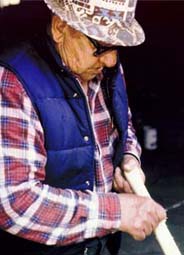Woodsman
Crooked knives were readily adopted and used by Franco-American, Franco and Anglo Canadian, and Scandinavian woodsmen, who recognized the utility of this knife form, which required no vice to hold the object being worked. In the Maine woods, lumbermen used crooked knives to make ax handles and wooden “folk art” carvings. Crooked knives were also used to make waterfowl decoys and were readily found in the tool boxes of Maine farmers, carpenters and canoe company employees.
Like their Native American counterparts, these crooked knives often had carved hardwood handles. Mirrors and even photos of “sweethearts” were often inlaid in the handle. Others were decorated with playing card motifs (hearts, diamonds, spades and clubs) or have the owner’s initials or dates as part of their designs.

Image courtesy of the Maine Folklife Center, the University of Maine. Catalog Number S-793
